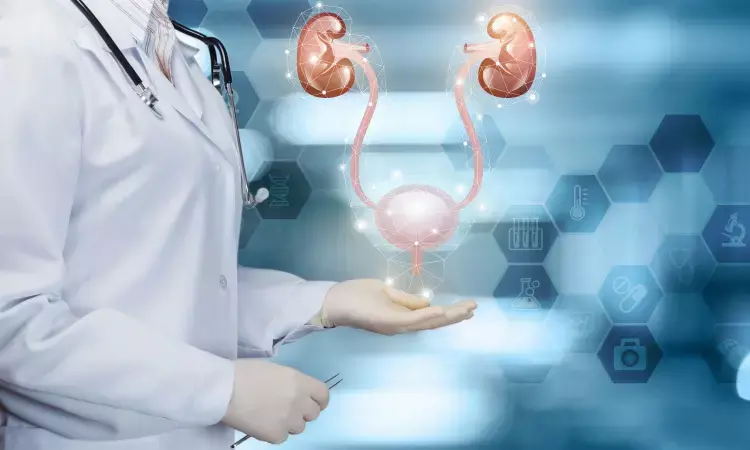- Home
- Medical news & Guidelines
- Anesthesiology
- Cardiology and CTVS
- Critical Care
- Dentistry
- Dermatology
- Diabetes and Endocrinology
- ENT
- Gastroenterology
- Medicine
- Nephrology
- Neurology
- Obstretics-Gynaecology
- Oncology
- Ophthalmology
- Orthopaedics
- Pediatrics-Neonatology
- Psychiatry
- Pulmonology
- Radiology
- Surgery
- Urology
- Laboratory Medicine
- Diet
- Nursing
- Paramedical
- Physiotherapy
- Health news
- Fact Check
- Bone Health Fact Check
- Brain Health Fact Check
- Cancer Related Fact Check
- Child Care Fact Check
- Dental and oral health fact check
- Diabetes and metabolic health fact check
- Diet and Nutrition Fact Check
- Eye and ENT Care Fact Check
- Fitness fact check
- Gut health fact check
- Heart health fact check
- Kidney health fact check
- Medical education fact check
- Men's health fact check
- Respiratory fact check
- Skin and hair care fact check
- Vaccine and Immunization fact check
- Women's health fact check
- AYUSH
- State News
- Andaman and Nicobar Islands
- Andhra Pradesh
- Arunachal Pradesh
- Assam
- Bihar
- Chandigarh
- Chattisgarh
- Dadra and Nagar Haveli
- Daman and Diu
- Delhi
- Goa
- Gujarat
- Haryana
- Himachal Pradesh
- Jammu & Kashmir
- Jharkhand
- Karnataka
- Kerala
- Ladakh
- Lakshadweep
- Madhya Pradesh
- Maharashtra
- Manipur
- Meghalaya
- Mizoram
- Nagaland
- Odisha
- Puducherry
- Punjab
- Rajasthan
- Sikkim
- Tamil Nadu
- Telangana
- Tripura
- Uttar Pradesh
- Uttrakhand
- West Bengal
- Medical Education
- Industry
Immediate urinary catheter removal after benign non-hysterectomy gynaecological laparoscopic surgery tied to higher risk of urinary retention

A study published in BJOG: An International Journal of Obstetrics & Gynaecology entitled "Immediate versus delayed urinary catheter removal following non-hysterectomy benign gynaecological laparoscopy: a randomised trial" by Lalla McCormack et al. and the team has concluded that there is no reduction in rates of UTI with immediate compared with delayed catheter removal.
They added that Clinicians favouring immediate removal of IDC and earlier discharge should know about the associated increased risk of urinary retention. Patients could be informed that there is approximately a 1 in 12 chance of needing the reinsertion of a urinary catheter for managing retention.
In the present study, a team of researchers compared rates of urinary retention and postoperative urinary tract infection between women with immediate versus women with the delayed removal of the indwelling catheter following benign non-hysterectomy gynaecological laparoscopic surgery. Urinary retention and urinary tract infection were the co-primary outcomes measured in the study.
The secondary outcomes researchers measured in this study were the hospital readmission, analgesia requirements, duration of hospitalisation, and validated bladder function questionnaires.
The study design was a randomised clinical trial (February 2012 and December 2019) with follow-up to 6 weeks and was conducted in two university-affiliated teaching hospitals in Sydney, Australia.
The research could be summarised as:
- A total of 693 women were included, aged 18 years or over.
- These women were undergoing non-hysterectomy laparoscopy for benign gynaecological conditions.
- Conditions like pelvic floor or concomitant bowel surgery were included.
- Three hundred fifty-five participants were randomised to the immediate removal of a urinary catheter and 338 to delayed removal of a urinary catheter.
- There was higher Urinary retention following immediate compared with the delayed urinary catheter removal.
- The urinary tract infection following delayed and immediate removal of the urinary catheter was 7.2 % and 4.7%, respectively. The difference was insignificant.
Concluding further, they said the risk of urinary retention is higher with the immediate than delayed removal of the urinary catheter following benign non-hysterectomy gynaecological laparoscopic surgery.
Though the UTI difference was insignificant, they mentioned.
There is a 1/12 risk of re-catheterisation after immediate urinary catheter removal. It is vital to ensure patients report normal voiding and emptying before discharge to reduce the need for readmission to manage urinary retention.
The major study limitation was related to the loss of follow-up rate, the discrepancy in data, and external validity.
They said, “There is an increasing move towards earlier postoperative discharge. Good postoperative bladder care is an important consideration.”
As acknowledged, the study received financial support from two research grants from the Australasian Gynaecological Endoscopy & Surgery (AGES) Society.
Further reading:
https://obgyn.onlinelibrary.wiley.com/doi/10.1111/1471-0528.17442
BDS, MDS in Periodontics and Implantology
Dr. Aditi Yadav is a BDS, MDS in Periodontics and Implantology. She has a clinical experience of 5 years as a laser dental surgeon. She also has a Diploma in clinical research and pharmacovigilance and is a Certified data scientist. She is currently working as a content developer in e-health services. Dr. Yadav has a keen interest in Medical Journalism and is actively involved in Medical Research writing.
Dr Kamal Kant Kohli-MBBS, DTCD- a chest specialist with more than 30 years of practice and a flair for writing clinical articles, Dr Kamal Kant Kohli joined Medical Dialogues as a Chief Editor of Medical News. Besides writing articles, as an editor, he proofreads and verifies all the medical content published on Medical Dialogues including those coming from journals, studies,medical conferences,guidelines etc. Email: drkohli@medicaldialogues.in. Contact no. 011-43720751


